| Serrano Bulldog | |||||||||||||||||||||||||||||
|---|---|---|---|---|---|---|---|---|---|---|---|---|---|---|---|---|---|---|---|---|---|---|---|---|---|---|---|---|---|
 | |||||||||||||||||||||||||||||
| Other names |
| ||||||||||||||||||||||||||||
| Common nicknames |
| ||||||||||||||||||||||||||||
| Origin | Brazil | ||||||||||||||||||||||||||||
| |||||||||||||||||||||||||||||
| |||||||||||||||||||||||||||||
| Dog ( domestic dog ) | |||||||||||||||||||||||||||||
The Serrano Bulldog (Portuguese : Buldogue serrano) is a Brazilian dog breed recognized by the Brazilian Confederation of Cynophilia (CBKC). [1]
| Serrano Bulldog | |||||||||||||||||||||||||||||
|---|---|---|---|---|---|---|---|---|---|---|---|---|---|---|---|---|---|---|---|---|---|---|---|---|---|---|---|---|---|
 | |||||||||||||||||||||||||||||
| Other names |
| ||||||||||||||||||||||||||||
| Common nicknames |
| ||||||||||||||||||||||||||||
| Origin | Brazil | ||||||||||||||||||||||||||||
| |||||||||||||||||||||||||||||
| |||||||||||||||||||||||||||||
| Dog ( domestic dog ) | |||||||||||||||||||||||||||||
The Serrano Bulldog (Portuguese : Buldogue serrano) is a Brazilian dog breed recognized by the Brazilian Confederation of Cynophilia (CBKC). [1]
Serrano is a Portuguese word widely used in Brazil as a term for those who are from regions with hills; it is a synonym of hillside or mountain used as substantive adjectives. [2]
A guardian of balanced temperament; does not show gratuitous aggression to people or other dogs, but does not exite in attacking under command or when provoked; has extreme submission to its owner. [1]
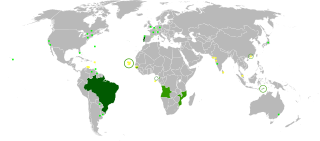
Portuguese is a Romance language originating in the Iberian Peninsula of Europe. It is the sole official language of Portugal, Angola, Mozambique, Guinea-Bissau, Cape Verde, São Tomé and Príncipe, and Brazil, while having co-official language status in East Timor, Equatorial Guinea, and Macau. A Portuguese-speaking person or nation is referred to as "Lusophone". As the result of expansion during colonial times, a cultural presence of Portuguese and Portuguese creole speakers are also found around the world. Portuguese is part of the Ibero-Romance group that evolved from several dialects of Vulgar Latin in the medieval Kingdom of Galicia and the County of Portugal, and has kept some Celtic phonology and its lexicon.

The flag of Brazil, known in Portuguese as Verde e amarela, or less usually Auriverde, is a blue disc depicting a starry sky spanned by a curved band inscribed with the national motto "Ordem e Progresso", within a yellow rhombus, on a green field. Brazil officially adopted this design for its national flag on November 19, 1889 — four days after the Proclamation of the Republic, to replace the flag of the Empire of Brazil. The concept was the work of Raimundo Teixeira Mendes, with the collaboration of Miguel Lemos, Manuel Pereira Reis and Décio Villares.
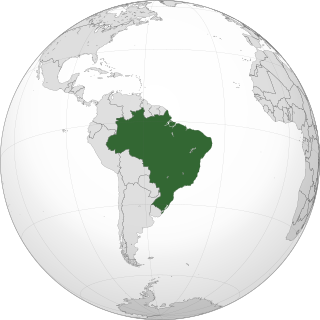
Brazilian Portuguese is the set of dialects of the Portuguese language native to Brazil and the most influential form of Portuguese worldwide. It is spoken by almost all of the 200 million inhabitants of Brazil and spoken widely across the Brazilian diaspora, today consisting of about two million Brazilians who have emigrated to other countries.

Hunsrückisch is a German dialect spoken in the Hunsrück region of Germany (Rhineland-Palatinate). This mountainous region of Germany has long been an exporter of emigrants to Brazil, United States, Canada, Australia and other parts of the world.
Hunsrik, also called Riograndenser Hunsrückisch, is a Moselle Franconian language derived primarily from the Hunsrückisch dialect of West Central German. The language has some recognition mainly in Brazil. It is an integral part of the historical and cultural heritage of Rio Grande do Sul since 2012, and is considered an immaterial cultural heritage of Santa Catarina since 2016. It is also a co-official language in the municipalities of Antônio Carlos, Santa Maria do Herval and São João do Oeste. In Brazil, Hunsrik is spoken in the states of Rio Grande do Sul, Santa Catarina and Paraná. The language is also spoken in some regions of northeastern Argentina and southern Paraguay.

The Fila Brasileiro, or Brazilian Mastiff, is a large working breed of dog developed in Brazil. It is known for its superb tracking ability, aggressiveness and an unforgiving, impetuous temperament. Rather than attacking its prey, the Fila traps it and waits for the hunter to arrive. Owing to these qualities, the Fila Brasileiro is used as a guard dog, as a cattle dog for livestock and as a hunting dog for tracking and controlling large game. When slavery was legal in Brazil in the 18th century, the Fila Brasileiro was used to return fugitive slaves unharmed to their masters.
The German-based varieties spoken by German Brazilians together form a significant minority language in Brazil. "Brazilian German" is strongly influenced by Portuguese and to a lesser extent by Italian dialects as well as indigenous languages. German dialects and Germanic languages are particularly strong in Brazil's South and Southeast Regions. According to Ethnologue, ca. 3 million people in Brazil speak the Hunsrik Language, 1.5 million speak Standard German and 8,000 speak Plautdietsch.

Bulldogs are a type of dog that were traditionally used for the blood sports of baiting and dog fighting, but today are kept for other purposes, including companion dogs, guard dogs and catch dogs. Bulldogs are typically stocky, powerful, square-built animals with large, strong, brachycephalic-type muzzles. It is believed bulldogs were developed during the 16th century in the Elizabethan era from the larger mastiffs, as smaller, more compact dogs were better suited for baiting.

Time in Brazil is calculated using standard time, and the country is divided into four standard time zones: UTC−02:00, UTC−03:00, UTC−04:00 and UTC−05

Yvonne Lara da Costa, better known as Dona Ivone Lara, was a Brazilian singer and composer.

The American Bully is a recently formed companion dog breed, originally recognized in 2004 by the American Bully Kennel Club (ABKC) and followed by the European Bully Kennel Club (EBKC) in 2008. It has been recognized by the United Kennel Club (UKC) since July 15, 2013. The breed has not been recognized by the American Kennel Club (AKC). The American Bully is a small to large breed, which has been divided into four categories by some registering organizations, including Pocket, Standard, Classic, and XL. Other organizations, including the UKC, have one consistent size standard.

Serrano do Maranhão is a municipality in the state of Maranhão in the Northeast region of Brazil.
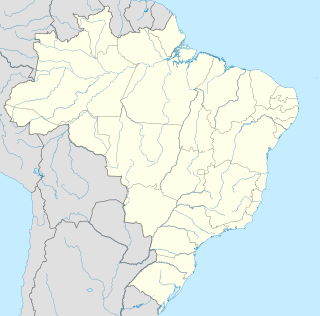
Serranos is a municipality in the state of Minas Gerais in the Southeast region of Brazil.
Miguxês, also known in Portugal as pita talk or pita script, is an Internet slang of the Portuguese language, commonly used by mostly Brazilian teenagers in Internet and other electronic media, such as messages written in cell phone.
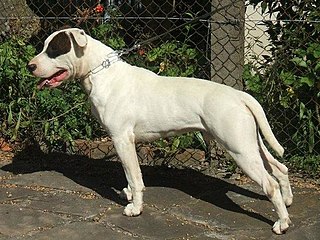
Brazilian Dogo, also called Brazilian Dogge, is a Molosser-type working dog breed originating in Brazil. It is neither recognized by the Fédération Cynologique Internationale (FCI) nor the American Kennel Club (AKC). However, it has the official Brazilian recognition by the Brazilian Confederation of Cynophilia (CBKC) where it belongs to the Group 11 - Breeds not recognized by the FCI.
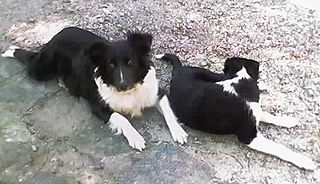
The Gaucho Sheepdog (Portuguese: Ovelheiro gaúcho) is a dog breed that originated in the Gaucho Pampas, Brazil. The breed is not recognized by the Fédération Cynologique Internationale (FCI), but it has been recognized by the CBKC, a Brazilian kennel club affiliated with FCI. Dogs of this breed are often characterized as sturdy and agile, which makes them suitable for herding activities. The Gaucho sheepdog is widely used for herding sheep and other livestock, especially in the southern region of Brazil.

The Campeiro Bulldog is a breed of bulldog from Brazil.

Pampas Deerhound is a Brazilian breed of hunting dog; it is also found in Argentina and Uruguay. It is common in Brazil, where it was first recognized by a national kennel club. The dogs were used to track, capture, and hunt deer, and thus earned the name Pampas Deerhound. It is still a widely preferred hunting companion to track other animals, such as wild boars.
Confederação Brasileira de Cinofilia or CBKC is a Brazilian kennel club confederation based in Rio de Janeiro. The confederation is affiliated with the Fédération Cynologique Internationale (FCI), being the only representative of this system in Brazil.
Jovelina Pérola Negra, stage name of Jovelina Farias Belfort, was a Brazilian samba singer and songwriter. Known by her deep voice, she was a representative of the partido alto samba style, and considered an heir to Clementina de Jesus style of singing.
| Wikimedia Commons has media related to Serrano Bulldog . |